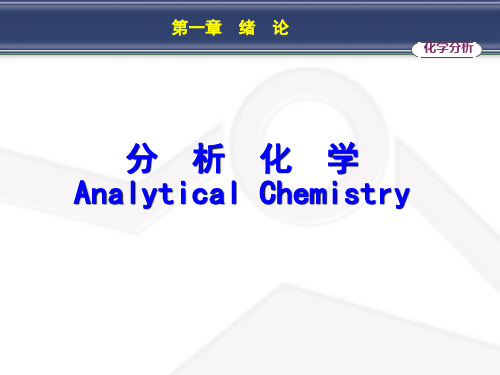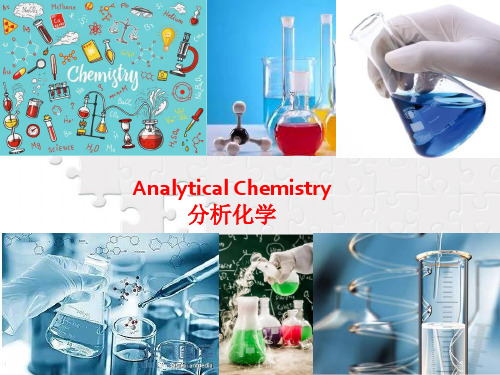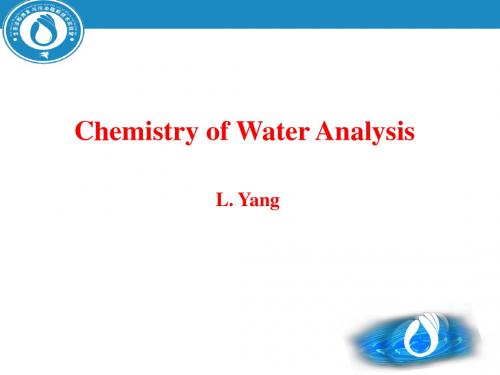分析化学英文PPT课件
合集下载
化学专业英语PPT课件

我们每个人的活动都牵涉到化学。我们洗浴、 做清洁、烹调食物。我们把一些化学制品用在 脸上、手上和头发上。
第7页/共31页
Collectively, we use tens of thousands of consumer chemical products in our homes.
总起来说,我们在家庭中使用成千上万种 消费化学品。
第21页/共31页
Knowledge of chemistry has already had a profound effect on the quality of life. Its impact on the future will be even more dprraomfoauntidc:.[prə’faund] adj. 深度的; 深切的; 深远的 dramatic:[drə’mætik] adj.戏剧性的, 激动人心的 化学知识已经对生活质量产生了深远的影响。 它对未来的影响将会更加激动人心。
malfunction: [mæl’fʌŋkʃən] n. 故障, 障碍 你的身体这个化工厂也产生它自己的能量。它发现 自己的故障,并能够再生和修复它的一些零部件。
第11页/共31页
It senses changes in its environment and adapts to these changes. With the aid of a neighboring facility, this fabulous factory can create other factories much like itself.
化学对社会和个人都有影响。化学是生物学、保健科学、 农业科学和地球科学的语言和基本工具。
第14页/共31页
Chemistry has illuminated the entire natural world; from the tiny atomic nucleus to the immense cosmos.
第7页/共31页
Collectively, we use tens of thousands of consumer chemical products in our homes.
总起来说,我们在家庭中使用成千上万种 消费化学品。
第21页/共31页
Knowledge of chemistry has already had a profound effect on the quality of life. Its impact on the future will be even more dprraomfoauntidc:.[prə’faund] adj. 深度的; 深切的; 深远的 dramatic:[drə’mætik] adj.戏剧性的, 激动人心的 化学知识已经对生活质量产生了深远的影响。 它对未来的影响将会更加激动人心。
malfunction: [mæl’fʌŋkʃən] n. 故障, 障碍 你的身体这个化工厂也产生它自己的能量。它发现 自己的故障,并能够再生和修复它的一些零部件。
第11页/共31页
It senses changes in its environment and adapts to these changes. With the aid of a neighboring facility, this fabulous factory can create other factories much like itself.
化学对社会和个人都有影响。化学是生物学、保健科学、 农业科学和地球科学的语言和基本工具。
第14页/共31页
Chemistry has illuminated the entire natural world; from the tiny atomic nucleus to the immense cosmos.
分析化学英文课件10分光光度法 Spectrophotometry

2.Molar absorptivityε
(1) Characteristic constant under certain condition for a
certain substance.
(2) Not change with c and wave path b. Under certain
temperature and wave length,εis only decided by the
c: concentration, g·L-1
a: absorptivity, L·g-1·cm-1
a andε: a =ε/ M (M : molar mass)
Transmittance: T
T : ratio of the radiant power transmitted to the incident radiant power :
ε = (6~10)× 104 : high sensitive;
ε = (2~6)× 104 : medium sensitive
ε < 2 × 104
: not sensitive。
Discrepancy of Lambert-beer’s law
The relationship between the absorbance and concentration may be nonlinear, which is the discrepancy of Lambert-Beer’s Law. The discrepancy may be caused by:
The selective absorbance and absorbance
curve
M + h → M*
分析化学-绪论ppt课件

1.2.6 例行分析和仲裁分析 例行分析:一般分析实验室对日常生产流程中
的产品质量指标进行检查控制的分析;
仲裁分析:不同企业部门间对产品质量和分析
结果由争议时,请权威的分析测试部门 进行裁判时的分析
.
1.2.7 分析方法的选择
对分析方法的选择通常应考虑以下几个方面:
a.测定的具体要求,待测组分及其含量范围,欲测组分的性质; b.共存组分的信息及其对测定想影响,合适的分离富集方法,分 析方法的选择性; c.对测定准确度、灵敏度的要求与对策; d.现有条件、测定成本及完成测定的时间要求等。
§1.5.1 定量分析工作的一般步骤
➢1 采样(sampling)
要使样品具有代表性 ➢ 要注意:
1.避免损失 2.避免不均匀; 3.保存完好; 4.足够的量以保证.分析的进行。
2 试样分解试样预处理
➢ 目的是利用有效的手段将样品处理成便于分 析的待测样品;
➢ 与待测样品有关的因素: 1. 分析方法(常量、微量); 2.物态与相(多相、均相、固态、液态、气态); 3.待测成分在样品中的含量(针对不同的分析方
• §1.2.2 按分析对象分类
• 1.无机分析(inorganic analysis) • 2.有机分析(organic analysis)
• §1.2.3 按分析方法分类
• 分析化学按其测定原理和操作方法的不同可 分为化学分析和仪器分析两大类。
.
1.化学分析法(Chemical analysis) 以化学反应为为基础的分析方法,称为 化学分析法,包括滴定分析法和重量分 析法.
➢在新产品、新工艺、新技术的开发研究和推 广等方面;
➢都离不开分析化学。
.
分析化学的作用
Analytical-ChemistryPPT课件

violent.
孙悟空破炉而出之后为何变得狂暴呢?因为他身上的碳酸钙变成了氧化钙,
吸收空气中的水分发生化学反应会发热,故而狂暴。
Then why Sun Wukong became mild? Because the Buddha[佛祖]
gave pressure to Sun Wukong with the five mountain, and
again.
后来孙悟空为啥又温和了呢?因为如来佛祖把孙悟空压在五行山下,常年风
吹日晒,孙悟空身上的氧化钙又吸收了雨水,随后变成了氢氧化钙,所以性
情也就变的温和了。
-
7
It is generally believed that the development of analytical chemistry subjects experienced three great change.
Because calcium carbonate [碳酸钙]in his body turned into calcium
oxide[氧化钙], the calcium oxide[氧化钙] took in the moisture[水分] in
the air ,and then produced chemical reaction, so he became
content of the component or the substance, to determine the
structure of the substance (chemical structure, crystal struct ure, spatial distribution)and existing form (valence state, coordination state, crystalline) and the relationship b etween material nature and itself. Its main aim is structural analysis,
分析化学英文课件05 酸碱滴定(法)Acid-Base Titrations

cKb ≥ 10-8.
§5.1.4 Titration of Polyprotic Acid
Take H3PO4 as an example pKa1 = 2.12; pKa1 = 7.20; pKa1 = 12.36
(1) At the first equivalence point, the first proton is neutralized forming H2PO4-
[H+] = Ka ca / cb = 10-4.74 [5.00 10-5 / (5.00 10-2)] =1.82 10-8
pH = 7.74
(3) At the equivalence point the solution of NaAc (weak base):
cb = 20.00 0.1000 / (20.00 + 20.00) = 5.00 10-2 mol/L
when [In-] / [HIn] = 1, middle color = 1/10, acid color = 10/1, base color
so the pH range for indicator to change color: pKHIn±1 (2) pH range for indicator to change color is decided by KHIn.
§5.1.2 Weak Acid Versus Strong Base
0.1000 mol/L NaOH titrate 20.00 mL 0.1000 mol/L HAc.
(1) Before the titration, 0.1000 mol/L HAc solution
[H ] ca Ka 0.1000 104.74 102.87
§5.1.4 Titration of Polyprotic Acid
Take H3PO4 as an example pKa1 = 2.12; pKa1 = 7.20; pKa1 = 12.36
(1) At the first equivalence point, the first proton is neutralized forming H2PO4-
[H+] = Ka ca / cb = 10-4.74 [5.00 10-5 / (5.00 10-2)] =1.82 10-8
pH = 7.74
(3) At the equivalence point the solution of NaAc (weak base):
cb = 20.00 0.1000 / (20.00 + 20.00) = 5.00 10-2 mol/L
when [In-] / [HIn] = 1, middle color = 1/10, acid color = 10/1, base color
so the pH range for indicator to change color: pKHIn±1 (2) pH range for indicator to change color is decided by KHIn.
§5.1.2 Weak Acid Versus Strong Base
0.1000 mol/L NaOH titrate 20.00 mL 0.1000 mol/L HAc.
(1) Before the titration, 0.1000 mol/L HAc solution
[H ] ca Ka 0.1000 104.74 102.87
分析化学完整版PPT课件

化学定量分析 :根据化学反应中试样和试剂的用量, 测定物质各组分的含量
化学定性分析:根据分析化学反应的现象和特征鉴定 物质的化学成分
滴定分析(titrimetric analysis )
重量分析(gravimetric analysis)
第一章 绪 论
3. 按照分析方法的原理分类(2)
化学分析
仪器分析(instrumental analysis):使用较特殊仪 器进行分析的方法 (以物质的物理或物理化学性质为基
第一章 绪 论
化学分析
作为一门科学的分析化学的形成: 20 世纪初,以溶液四大平衡理论为基础。 化学分析法迅速发展成为系统理论和方 法。
第一章 绪 论
化学分析
以仪器分析为主的现代分析化学:20世 纪40~60年代,物理学与电子学的发展 促进分析化学的发展。光谱分析、极谱 分析及其理论体系。 经济、社会发展的需求是动力
药学专业的重要专业基础课
第一章 绪 论
化学分析
第二节 分析化学的发展
第一章 绪 论
化学分析
分析化学的诞生 :18世纪,在氧化汞 形成实验中的定量测定,拉瓦锡(AL.
Lavoisier) --分析化学之父。
滴定分析的产生:直接动力是化学工业 的兴起。 18世纪时,硫酸、盐酸、苏 打和氯水是化学工业的中心产品。最早 的“滴定分析” ,法国人日夫鲁瓦测 定醋酸的浓度,将醋酸滴加入碳酸钾中。
微量组分分析 (0.01%~1%)
痕量(组分)分析 (<0.01%)
注意与试样用量分类法的区别
第一章 绪 论
化学分析
第四节
分析过程和步骤
第一章 绪 论
化学分析
明确分析任务和制订计划(包括标准操作程序,SOP)
分析化学英文课件13红外光谱学IR

(2) Steric effect field effect;sterically hindered effect;cyclic tension.
CH
3060-3030 cm-1
2900-2800 cm-1
1576cm-1 1611cm-1 1644cm- 1
C H2 C H2
1781cm-1 1678cm-1
Infrared spectrum
Ordinate: absorbance, Abscissa: wavelength λ(m) and wave number 1/λ (cm-1)
Described by Number, position, shape of peaks
Application: structure determination of organic molecules. Qualitation: characteristic absorptive frequency. quantitation: strength of absorptive peak.
Fundamental frequency peak.
(5) Transition from ground state to second excited state , creation of a weak absorptive
peak
frequency peak(倍频峰).
§13.1.4 Factor of the Effected the Position of Absorptive Peaks
Infrared active and infrared inactive
Symmetrical diatomics:
No change in dipole moment,infrared inactive Such as: N2, O2, Cl2, etc. Asymmetric molecules: Change in dipole moment,infrared active. Such as: HCl, H2O
分析化学英文课件03滴定分析基础 Fundamentals of Titrimetric Analysis

of Standard Solutions §3.4 Calculations in Titrimetric
Analysis
§3.1 General Principlmeosving
§3.1.1 Some General Aspect
In a titration, the test substance (analyte) reacts with a reagent added as a solution of known concentration--refered to as a standard solution, and it is generally added from a buret.
For example, in acid-base titrations, solutions of hydrochloric acid and sodium hydroxide are so prepared, and it is customary to standardize one of them against a secondary standard to obtain the concentration of the other solution.
§3.3 Ways of Expressing Concentration of Standard Solution
§3.3.1Concentration of Amount Substance
——the amount of substance in unit volume
Molarity--a kind of concentration expression. If nB moles of substance B are contained in V liters of solution, the concentration of substance B is given by cB = nB/V, The commonly used unit is mol/L.
Analysis
§3.1 General Principlmeosving
§3.1.1 Some General Aspect
In a titration, the test substance (analyte) reacts with a reagent added as a solution of known concentration--refered to as a standard solution, and it is generally added from a buret.
For example, in acid-base titrations, solutions of hydrochloric acid and sodium hydroxide are so prepared, and it is customary to standardize one of them against a secondary standard to obtain the concentration of the other solution.
§3.3 Ways of Expressing Concentration of Standard Solution
§3.3.1Concentration of Amount Substance
——the amount of substance in unit volume
Molarity--a kind of concentration expression. If nB moles of substance B are contained in V liters of solution, the concentration of substance B is given by cB = nB/V, The commonly used unit is mol/L.
分析化学英文课件01绪论 Introduction

(3). Biological analysis
(Байду номын сангаас). Medicine analysis
3. According to analytical methods
(1).Chemical analysis (2).Instrumental analysis
4. According to size of sample (1)macro analysis (2)microanalysis (3)trace analysis
Composition (3). Structure
Stereochemical structure, structure and activity
2. According to analytical object
(1). Inorganic analysis (2). Organic analysis (3). Biological analysis (4). Medicine analysis
Dissolve sample and eliminate interference
3. Measurement
Select a suitable analytical method
4. Calculation and evaluation of the results
Calculate and evaluate the results
Analysis
Chapter 1 Introduction
§1.1 Generalization §1.2 The Analytical Process §1.3 Classification of Ana. Chem. §1.4 Development of Ana.Chem.
(Байду номын сангаас). Medicine analysis
3. According to analytical methods
(1).Chemical analysis (2).Instrumental analysis
4. According to size of sample (1)macro analysis (2)microanalysis (3)trace analysis
Composition (3). Structure
Stereochemical structure, structure and activity
2. According to analytical object
(1). Inorganic analysis (2). Organic analysis (3). Biological analysis (4). Medicine analysis
Dissolve sample and eliminate interference
3. Measurement
Select a suitable analytical method
4. Calculation and evaluation of the results
Calculate and evaluate the results
Analysis
Chapter 1 Introduction
§1.1 Generalization §1.2 The Analytical Process §1.3 Classification of Ana. Chem. §1.4 Development of Ana.Chem.
Chapter 1 水分析化学英文课件

Example:Two objects were weighed to be 1.6380 g and 0.1637 g, respectively. It is supposed that the true weights for them are 1.6381 g and 0.1636 g. Please give out the corresponding absol ute vales and relative values. E = 1.6380 g – 1.6381 g = -0.0001 g Absolute value: E = 0.1637 g - 0.1636 g = 0.0001 g Er = -0.0001/1.6381×100% = -0.006% Er = 0.0001/0.1638×100% = 0.06%
IV :industrial water, and entrainment water V :agricultrial water, and landscapewater
1.5
Error
Data analysis
Error is the difference between true value and determined value.
During the cycling process, impurities such as heavy metals, toxic organic chemicals, compounds, carbon dioxide, bacterials, humus, protein, sand, algae, and mud can be dissolved and involved in the water.
Uncertainty means the amount by which a measured value deviates from the true value.
- 1、下载文档前请自行甄别文档内容的完整性,平台不提供额外的编辑、内容补充、找答案等附加服务。
- 2、"仅部分预览"的文档,不可在线预览部分如存在完整性等问题,可反馈申请退款(可完整预览的文档不适用该条件!)。
- 3、如文档侵犯您的权益,请联系客服反馈,我们会尽快为您处理(人工客服工作时间:9:00-18:30)。
Change the sample'status for feasible measurement.
3. Measuring
Convenient method and instrument.
4. Calculating and evaluating
Data process. Error
2021/2/12
Effect 1. 灵敏度 sensitivity 2. 精确度 precision 3. 系统误差 bias 4. 准确度 accuracy 5. 检出限 limit of detection 6. 检测限 limit of determination 7. 选择性 selectivity 8. 动态范围 dynamic range
because of salary 6. Sample throughput 7. Costs of reagents
2021/2/12
College of Chemistry & Chemical Engineering
8
What are we interested?
Evaluating analytical data (parts in chapter 2-4 )
High throughput and high speed 高通量、快速分析
auto- 自动化、micro- 微型化、image- 图像化
2021/2/12
College of Chemistry & Chemical Engineering
7
How to estimate a method? 分析方法的评价
Chromatographic methods.
2021/2/12
College of Chemistry & Chemical Engineering
9
How to express the results
SI units: stands for System International unites. Internationally
Object:determine how much of a constituent species is
present in a samห้องสมุดไป่ตู้le.
2021/2/12
College of Chemistry & Chemical Engineering
3
Analytical approach
Identify and define the problem Design the experimental procedure Conduct an experiment, and gather data Analyze the experimental data Propose a solution to the problem
Chemical analysis --- titration (chapter 9)
Acid-base, Complexation,
Redox,
Precipitation.
Instrumental analysis (chapter 10, parts in chapter11-12)
Spectrscopic methods,
2021/2/12
College of Chemistry & Chemical Engineering
4
Experimental process
1. Sampling
Accuratly represent the population from which it is drawn
2. Pre-treating
agreed on units for measurements.
2021/2/12
College of Chemistry & Chemical Engineering
10
2021/2/12
College of Chemistry & Chemical Engineering
2021/2/12
College of Chemistry & Chemical Engineering
2
• Qualitative analysis
Object:determine the identity of the constituent species
in a sample.
• Quantitative analysis
College of Chemistry & Chemical Engineering
5
An example: improving established methods.
2021/2/12
College of Chemistry & Chemical Engineering
6
The analytical perspective
Cost 1. Costs of investment 2. Duration of analysis with regard
to personnel costs 3. Special safety precaution 4. Costs of installation, housing 5. Degree of training operator
Analytical Chemistry
分析化学
What is analytical chemistry?
Performing an analysis on a sample (chemical analysis)
Improving established methods, extending existing methods to a new types of samples, and developing new methods for measuring chemical phenomena.
High sensitivity 高灵敏度 ――single-molecular level
High selectivity 高选择性 ――complex system(cell、medicine)
In situ, in vivo, real-time, label-free
原位、活体、实时、无损分析
3. Measuring
Convenient method and instrument.
4. Calculating and evaluating
Data process. Error
2021/2/12
Effect 1. 灵敏度 sensitivity 2. 精确度 precision 3. 系统误差 bias 4. 准确度 accuracy 5. 检出限 limit of detection 6. 检测限 limit of determination 7. 选择性 selectivity 8. 动态范围 dynamic range
because of salary 6. Sample throughput 7. Costs of reagents
2021/2/12
College of Chemistry & Chemical Engineering
8
What are we interested?
Evaluating analytical data (parts in chapter 2-4 )
High throughput and high speed 高通量、快速分析
auto- 自动化、micro- 微型化、image- 图像化
2021/2/12
College of Chemistry & Chemical Engineering
7
How to estimate a method? 分析方法的评价
Chromatographic methods.
2021/2/12
College of Chemistry & Chemical Engineering
9
How to express the results
SI units: stands for System International unites. Internationally
Object:determine how much of a constituent species is
present in a samห้องสมุดไป่ตู้le.
2021/2/12
College of Chemistry & Chemical Engineering
3
Analytical approach
Identify and define the problem Design the experimental procedure Conduct an experiment, and gather data Analyze the experimental data Propose a solution to the problem
Chemical analysis --- titration (chapter 9)
Acid-base, Complexation,
Redox,
Precipitation.
Instrumental analysis (chapter 10, parts in chapter11-12)
Spectrscopic methods,
2021/2/12
College of Chemistry & Chemical Engineering
4
Experimental process
1. Sampling
Accuratly represent the population from which it is drawn
2. Pre-treating
agreed on units for measurements.
2021/2/12
College of Chemistry & Chemical Engineering
10
2021/2/12
College of Chemistry & Chemical Engineering
2021/2/12
College of Chemistry & Chemical Engineering
2
• Qualitative analysis
Object:determine the identity of the constituent species
in a sample.
• Quantitative analysis
College of Chemistry & Chemical Engineering
5
An example: improving established methods.
2021/2/12
College of Chemistry & Chemical Engineering
6
The analytical perspective
Cost 1. Costs of investment 2. Duration of analysis with regard
to personnel costs 3. Special safety precaution 4. Costs of installation, housing 5. Degree of training operator
Analytical Chemistry
分析化学
What is analytical chemistry?
Performing an analysis on a sample (chemical analysis)
Improving established methods, extending existing methods to a new types of samples, and developing new methods for measuring chemical phenomena.
High sensitivity 高灵敏度 ――single-molecular level
High selectivity 高选择性 ――complex system(cell、medicine)
In situ, in vivo, real-time, label-free
原位、活体、实时、无损分析
